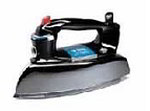Pressing or Folding in Garment Manufacturing
Although pressing remains largely a manual task, new automated process exists that apply force and steam to garments placed over a body form.
Pressing or Folding

Some pressing, termed “under pressing,” may be done in the course of assembling a garment, for example, pressing seams open or ironing a collar. Most pressing is done after assembly to improve the appearance of a garment. In other cases, especially with knits, garments are simply folded instead of pressed. Although pressing remains largely a manual task, a new automated process exists that apply force and steam to garments placed over a body form.
Finishing and Detailing
“Finishing” is the addition of special detailing such as pleats, embroidery and screen printing to a garment. This includes hand stitching (unseen handwork is done inside collars and lapels to give them shape) and its automated substitutes. This may also include adding buttons, hooks, eyes, or trims, as well as clipping loose threads. All finishing of moderate- and lower-priced garments is done by machine.
The Principles of Pressing
Pressing can be defined as a process which changes the geometric fiber structure of the area being pressed by the controlled application of heat, steam, and pressure. In this sense, removing a crease from a garment involves the same change of fiber lay as that required to open a seam or to press a hem.
With very few exceptions, every type of product manufactured by the clothing industry is pressed either during or at the end of its assembly or at the end only. The exceptions are items of corsetry and underwear which, due to the materials and construction, do not require any form of pressing.Regardless of the extent of pressing which garment undergo, pressing is a crucial process which imparts the final finish to a garment. A garment always has a greater hanger or package appeal if itis fresh looking and crisply pressed.


